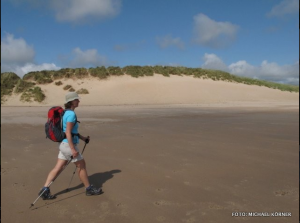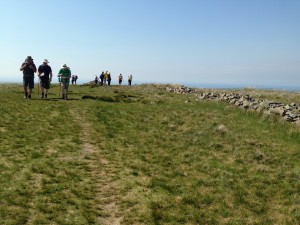Macs Maps: How to measure distance traveled
In the final instalment of our Macs Maps series, we'll be learning how to measure how far we've traveled. This is a useful skill to have, especially if you take a wrong turn somewhere and want to know how far away you are from your target location.
There are several different methods we'll be looking at: map measurements, pacing, timing and Naismith's rule.
If you know your location on the map, it's very easy to calculate how far you've traveled, simply use a ruler to measure the distance on the map and times this figure by the map scale. For example, if you have traveled 2cm (or 20mm) on the map, and the map uses a scale of 1:25000, this means that you have traveled 500 metres in reality. Helpfully, standard compasses have both a 1:25000 scale and a 1:50000 so you can avoid the calculations!



 So, now you've learnt about map features, grid references, orienting your map, pinpointing your map and measuring distance travelled, you're all ready to go and explore the great outdoors!
Here are a few tips to stay safe while using your map:
So, now you've learnt about map features, grid references, orienting your map, pinpointing your map and measuring distance travelled, you're all ready to go and explore the great outdoors!
Here are a few tips to stay safe while using your map:
If you know your location on the map, it's very easy to calculate how far you've traveled, simply use a ruler to measure the distance on the map and times this figure by the map scale. For example, if you have traveled 2cm (or 20mm) on the map, and the map uses a scale of 1:25000, this means that you have traveled 500 metres in reality. Helpfully, standard compasses have both a 1:25000 scale and a 1:50000 so you can avoid the calculations!

Pacing
In order to use pacing you must have a vague idea of how many double paces you take for each 100 metres. A person of average height is estimated to take around 65 double paces for every 100 metres. To find out your own pace count, measure 100 metres and walk normally, counting how many double paces you make within that distance. The accuracy of this method can be affected by underfoot conditions and slopes.
Timing
If you have an idea of how quickly you walk, you can calculate how long you will take to complete your walk. The average person will walk 4 kilometres or (2.85 miles) per hour. This is about 1.5 minutes per 100 metres. If, for example, you took a turn 6 minutes ago which you have now discovered is wrong, you will likely have walked about 400 metres. As above, the accuracy will be affect by underfoot conditions and slopes.
Naismith's Rule
Using timing and pacing to calculate distance travelled is most effected when exploring a flat landscape. However, unless you are in Holland, this is unlikely to be the case. To take into account the effect of slopes , a Scottish climber named William W. Naismith devised this simple formula: 5km per hour plus 30 minutes per 300 metres of ascent. So, now you've learnt about map features, grid references, orienting your map, pinpointing your map and measuring distance travelled, you're all ready to go and explore the great outdoors!
Here are a few tips to stay safe while using your map:
So, now you've learnt about map features, grid references, orienting your map, pinpointing your map and measuring distance travelled, you're all ready to go and explore the great outdoors!
Here are a few tips to stay safe while using your map:
- Always tell someone where you'll be going and what time you expect to be back
- Take a fully charged mobile phone with you with local mountain rescue contact numbers on it
- Check the weather forecast and take adequate clothing with you
- Be sure to take plenty water and some snacks

Written by
Ewan



 Australia
Australia New Zealand
New Zealand South Africa
South Africa European Union
European Union